International Conference “Cultures of Research”
March 25 to 27, 2025, Forum M, Buchkremerstraße 1-7, 52062 Aachen
The international conference “Cultures of Research” takes stock of the first four years of the fellow program at the Käte Hamburger Kolleg: Cultures of Rearch (c:o/re).
During these years, more than fifty international fellows came to the KHK c:o/re to explore the transformation of research in its many facets. Topics such as the digitalization of science, the growing influence of AI on research practices, the organizational transformations in science, the “engineering of science”, and the historical as well as intercultural comparison of “varieties of science” have been widely discussed.
The conference will focus the discussions on these topics in various panels with current and alumni fellows as well as members of the scientific advisory board of the KHK c:o/re.
A detailed program with all speakers and titles can be found in this document.

Program
| Time | Tuesday, 25th | Wednesday, 26th | Thursday, 27th |
| 09:00-12:00 | Welcome and Introduction | Panel 4 “Digitalisation of Science” Lecture by Franck Varenne | Panel 7 “Expanded STS” & Euregio |
| Panel 1 “Historicizing Science” Lecture by Hans-Jörg Rheinberger | |||
| Lunch | |||
| 13:00-15:30 | Panel 2 “Dealing with Complexity” Lecture by Mary Morgan | Panel 5 “Varieties of Science” Lecture by Alfred Nordmann | Panel 8 “Art and Research” |
| Coffee break | |||
| 16:00-18:00 | Panel 3 “Lifelikeness” | Panel 6 “Freedom of Research” Lectures by Frederik Stjernfelt & Steve Fuller | Departure |
| 18:00-20:00 | Evening Keynote Lecture by Ad Aertsen | Conference Dinner | |
| Reception (finger food) |
Get to know our Fellows: Carsten Reinhardt
Get to know our current fellows and gain an impression of their research. In a new season of short videos, we asked them to introduce themselves, talk about their work at the KHK c:o/re and the research questions that fascinate them.
How do chemical residues shape our understanding of uncertainty in modern society? In this video, Carsten Reinhardt, professor for historical studies of science at the University of Bielefeld, explores the concept of residual uncertainty and how unknown long-term effects of chemicals influence scientific debates and regulatory policies.
Check out our media section or our YouTube channel to have a look at the other videos.
Get to know our Fellows: Elisabeth Röhrlich
Get to know our current fellows and gain an impression of their research. In a new season of short videos, we asked them to introduce themselves, talk about their work at the KHK c:o/re and the research questions that fascinate them.
What lessons can the nuclear age teach us about regulating artificial intelligence? In this video, Elisabeth Röhrlich, associate professor in history at the University of Vienna, introduces her research on critical parallels between the early nuclear age and contemporary debates on AI governance.
Check out our media section or our YouTube channel to have a look at the other videos.
Fellow Publication: International Organizations and the Cold War
We are pleased to announce that the book “International Organizations and the Cold War. Competition, Cooperation, and Convergence” by Sandrine Kott, Eva-Maria Muschik and KHK c:o/re Fellow Elisabeth Röhrlich is now published and available as Open Access.
The post-WWII era was a time of superpower confrontation and antagonistic bloc politics, but it was also a period in which organized internationalism reached its peak as both an ideological value and a political practice. This open access volume explores how international organizations affected the evolution and nature of Cold War rivalries, and how they in turn were shaped by them.
In seeking to understand the role that international organizations have played as sites of confrontation, this volume also highlights their role as spaces for mediation and negotiation, particularly for middle-size powers and colonized or newly decolonized countries. Through multiple perspectives, based on a diverse array of historical sources, the authors collectively explore how international organizations were able to bridge and move beyond the Cold War divide by promoting common causes and shaping common scientific knowledge, communities and practices.
Rather than focusing exclusively on western-dominated institutions within the UN system which have received the most scholarly attention to date, “International Organizations and the Cold War” highlights the role of lesser-known groups such as the Paris-based International Child Center, the Prague-based International Union of Students and historical actors such as Soviet public health experts and Chinese development specialists. In doing so, it asks new questions about the role of international organizations in securing peace and security across the modern world, and their role as negotiator in times of tension and crisis.
Keynote by Hannah Star Rogers at the Materializing Methods Symposium
On February 20, 2025, KHK c:o/re Fellow Hannah Star Rogers will deliver the keynote at the Materializing Methods symposium at Durham University.
Materializing Methods is a one-day symposium hosted by the Discovery Research Platform for Medical Humanities at Durham University, in collaboration with The Cultural Negotiation of Science research group (Northumbria University) and Hannah Star Rogers (Medical Museion, University of Copenhagen).
What can practice-based research tell us about working with disciplinary cultures that are not our own? With a focus on how contemporary art practices engage with expert cultures in health and biomedicine, this symposium foregrounds questions of method, practice and process in relation to interdisciplinary inquiry. Critical art practices are knowledge-producing practices that shape interdisciplinary research agendas.

Photo credit: Molly Renda
If you are interested in participating, please visit the event website.
Get to know our Fellows: Sam Selma Ducourant
Get to know our current fellows and gain an impression of their research. In a new season of short videos, we asked them to introduce themselves, talk about their work at the KHK c:o/re and the research questions that fascinate them.
How does lifelikeness function as a mechanism of control? In this video, Sam Selma Ducourant, who works on the history and philosophy of sciences involved in animal production, discusses her research on the history of battery cages for chicken.
Check out our media section or our YouTube channel to have a look at the other videos.
Freedom of Research Summit: Call for Contributions
On November 5 and 6, 2025, the second edition of the Freedom of Research Summit will take place in Aachen, jointly organized by the Charlemagne Prize Foundation, RWTH Aachen University’s Knowledge Hub, and the Käte Hamburger Kolleg: Cultures of Research (c:o/re).

With the topic “Europe in Times of Division”, the Summit aims to address the complex challenges facing our continent today – ranging from political polarization and geopolitical tensions to economic disparities and environmental divides. How can we navigate these challenges and create a resilient framework for future developments?
This year, we invite you to take an active role in shaping the Symposium. We encourage you to participate in our Call for Contributions to explore the role of science as a bridge-builder in Europe within your specific research field or area of work and to reflect on the importance of academic freedom in this context. The Summit’s Symposium will take place on November 6, 2025 at the SuperC of RWTH Aachen University.
Please have a look at the Call for further information.
The application deadline is March 31, 2025.



If you are interested in a recap of last year’s symposium, here is a blog post.
Lab-Talk: KHK c:o/re meets E.ON Energy Research Center
On January 29, 2025, a group of fellows and staff members visited the Institute for Automation of Complex Power Systems at the E.ON Energy Research Center at RWTH Aachen University.
Professor Ferdinanda Ponci and her team gave us insights into their research topics and we learned about exciting EU projects such as EnerTEF. We also enjoyed a tour of the ACS lab and discovered many common interests ranging from AI and AI bias to hardware-in-the-loop topics.
As part of the Lab-Talks, KHK c:o/re fellows and staff visit various institutes at RWTH Aachen University to promote networking and interdisciplinary collaboration between STEM projects and the social sciences and humanities.




photo credits: Jana Hambitzer
Towards a Philosophy of Digitality: Gabriele Gramelsberger was awarded the K. Jon Barwise Prize
DAWID KASPROWICZ
On Thursday, January 9, 2025, KHK c:o/re director Gabriele Gramelsberger gave a lecture at the 121st annual meeting of the American Philosophical Association (APA), Eastern Division, in New York. Her lecture, titled “Philosophy of Digitality: The Origin of the Digital in Modern Philosophy”, was given in relation to the award of the K. Jon Barwise Prize by the APA in 2023 for her significant and sustained contributions to philosophy and computing.
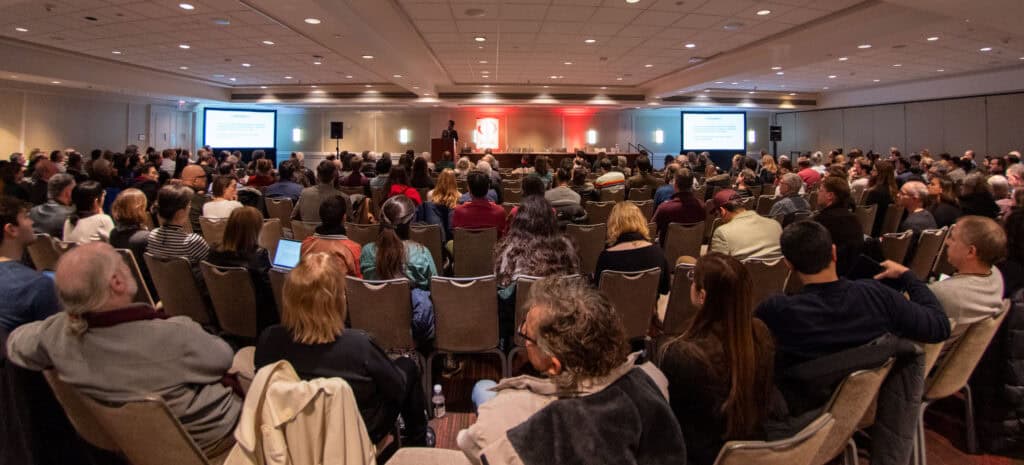
photo credits: American Philosophical Association
Robin Hill, computer scientist from the University of Wyoming and a longtime member of the APA, introduced Prof. Gramelsberger and chaired through the session. Named after the American mathematician and philosopher K. Jon Barwise, the prize honors since 2002 scholars for their lifelong efforts in the disciplines of philosophy and computing, especially in the fields of artificial intelligence and computer ethics. Next to Prof. Gramelsberger, who received the prize for 2023, the Israelian philosopher Oron Shagrir from the Hebrew University Jerusalem received the Barwise Prize for 2024. Among the former winners of the prize are well-known philosophers such as Daniel Dennett, David Chalmers or Jack Copeland. Gabriele Gramelsberger was the third woman who won this award.
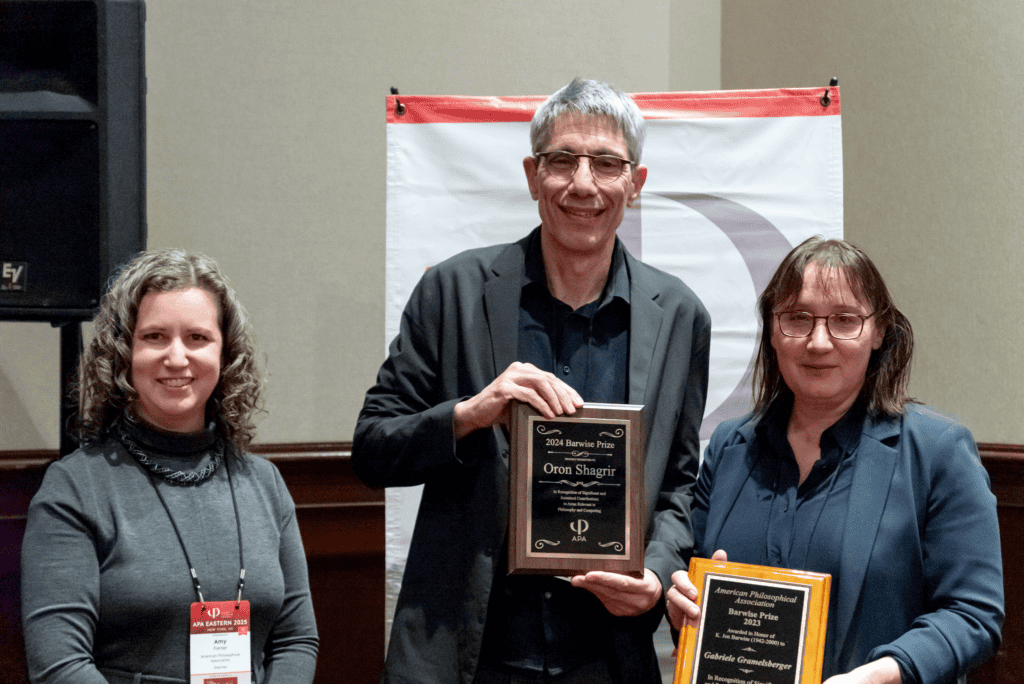
Prof. Gramelsberger presented two parts in her lecture: in the first, she introduced her conception of a philosophy of digitality since the modern age, and in the second, she highlighted some current challenges for philosophers to describe digitality as a socio-cultural phenomenon. It is not common in philosophy to relate the digital to thinkers of the modern age. In doing so, Prof. Gramelsberger began her talk with a schema how a prehistory of the digital could be written – a history that does not start with machines and technological objects, but with a reinterpretation of writings such as René Descartes’ Discourse de la méthode from 1637. In this classical book, Descartes did not only introduce a procedure how to separate right from wrong in scientific judging. Following Prof. Gramelsberger, he was also one of the first who systematically described thinking as a cognitive process, a process which could be distinguished in several steps that build up on each other. Instead of only considering the right inference from the premises (as done in syllogistic reasoning), Descartes also conceived thinking as a series of discrete steps that one has to execute appropriately to split a bigger problem into several smaller ones. It is this discrete and procedural way to describe thinking that we also find in the papers of the AI-pioneers Allan Newell and Herbert Simon and their General Problem Solver, as Prof. Gramelsberger argued.
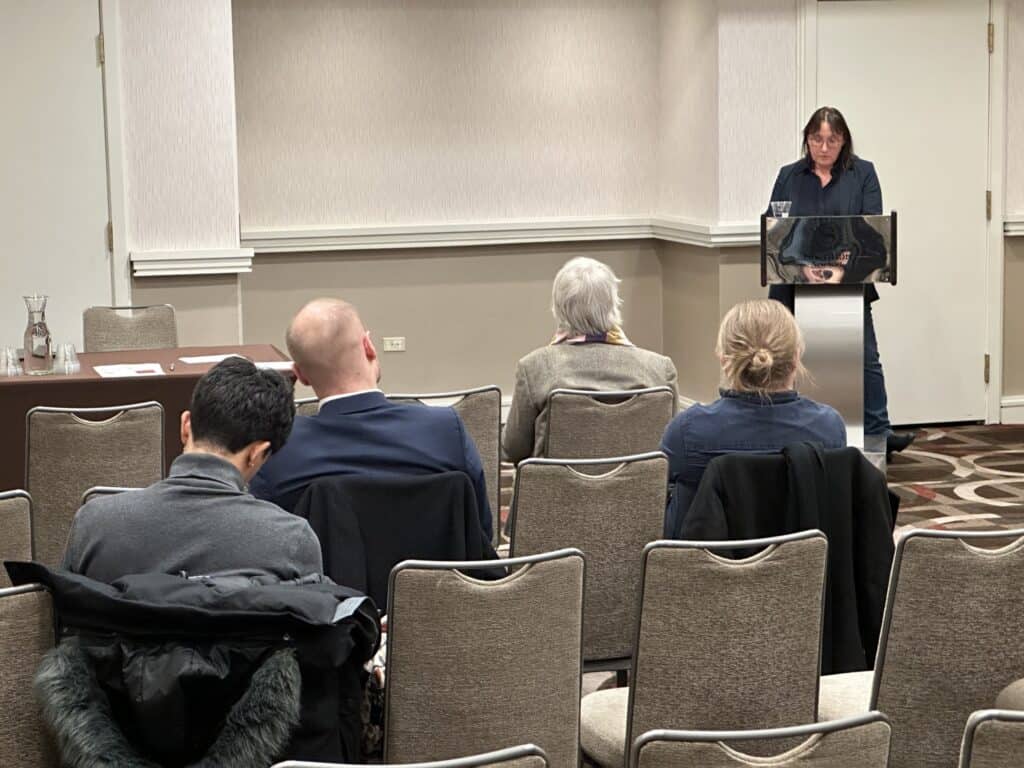
While Descartes introduced the first discretization of cognitive processes, Leibniz went further to describe cognitive operations with a symbolic system. This artificial language consisting of arithmetic, algebra and logic should constitute the adequation between the object and the concept, between the relations of objects and the judgments. In this sense, Leibniz not only introduced the symbolic order to formulate possible experiences in the real world, he was also able to replace the qualitative and substance-oriented with a formal and quantitative one. This equivalence of being with the formal calculus allowed him to extend the conditions of possible experiences into the transcendence of mathematical operations. From here, Prof. Gramelsberger argued, it is not far anymore to rule-based cognitive operations that could also be externalized – and this is exactly what pioneers of digital computers such as C. Babbage did in the 19th century (see also in Gramelsberger 2023, p. 40-44).
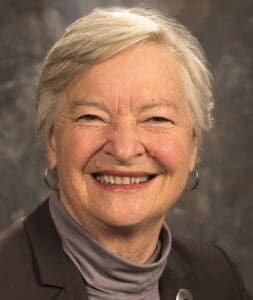
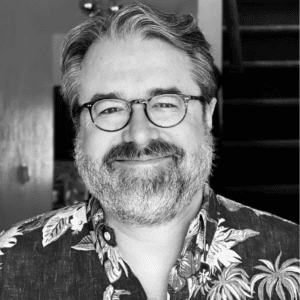
The execution of such mechanized operations happens today a billion times in a couple of seconds. Taking into consideration, as Prof. Gramelsberger highlighted, that there are more than five billion smartphones in the world, a philosophy of digitality has also to respond to digital cultures and their objects as an everyday experience of most people. In this regard, Prof. Gramelsberger presented in the second half of her talk a more critical and phenomenological approach. It is the operation of digital machines beneath our “phenomenological thresfold” that represents on the one hand a challenge for a philosophy of digitality, but on the other hand also a risk for the wellbeing of the users. In referring to the German concept of “cultural techniques” (Kulturtechniken) (Krämer and Bredekamp 2013), Prof. Gramelsberger illustrated that in cultural techniques such as writing, one always operates with discretized symbols – whether in alphabets or in the arithmetic sense. The fundamental difference with digital machines lies in the affective mode by which they address us, as the Barwise-awardee explained. Most often, the goal of social media communication would be to raise emotions, but the resources to do so are affects that are triggered beneath our threshold of intentional attention. At the end of her talk, Prof. Gramelsberger pointed sharply out to a threatening constellation where man has lost its ability to be “eccentric”, as the German philosopher Helmuth Plessner called it. Instead, in the age of an affective smartphone culture and massive data-storage (often owned by private companies), man becomes centric again and stays in one place to go through a myriad of affective-loaded communications that keep him in a loop to create even more data.
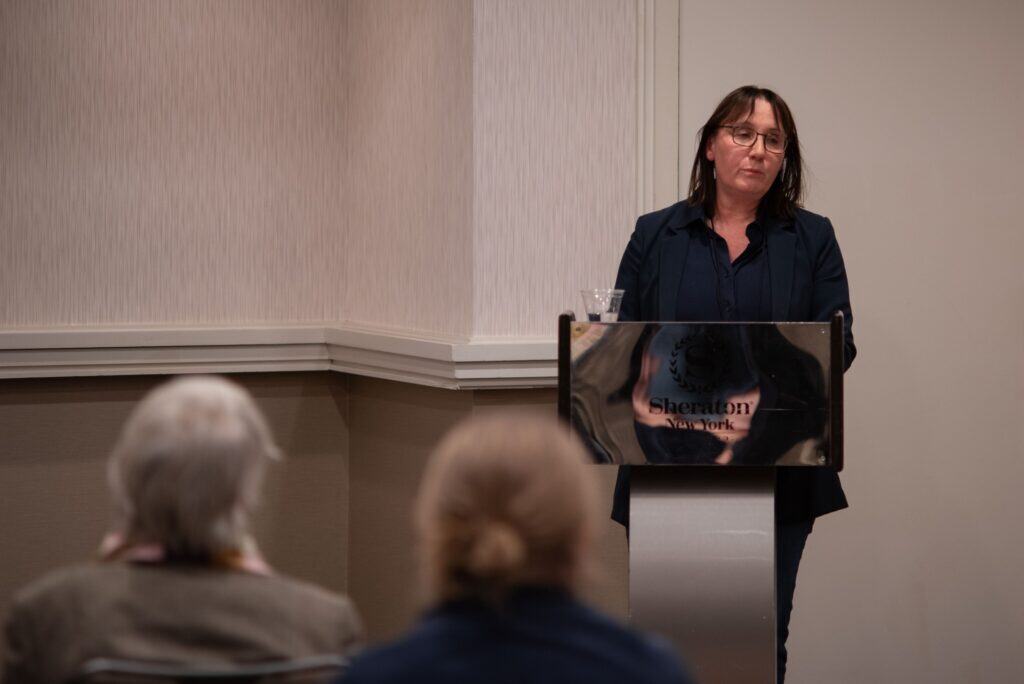
In his response to Prof. Gramelsberger’s talk, Zed Adams from the New School for Social Research in New York extracted three leading questions: These questions highlighted the relation of the analog and the digital, the question of the copy in the age of the digital, and the challenge how to describe the affective regime in our current smartphone culture. Adams offers to dig deeper into the challenge of a “Philosophy of Digitality” were also taken up vividly by the audience. Especially the distinction of affect and emotion evoked some discussions, but also the challenge how to describe the cultural impact of technologies such as AI with philosophical tools. A first answer was to find ways how to describe the less complex yet emotionally overwhelming ways we can observe in the use of social media apps. This could be a fist step to better understand how machines in the age of AI recentralize us as human beings – or decentralize us as the contingent result of data-management.
Gabriele Gramelsberger. 2023. Philosophie des Digitalen. Zur Einführung. Junius: Hamburg.
Sybille Krämer and Horst Bredekamp. 2013. Culture, Technology, Cultural Techniques – Moving Beyond Text. In: Theory, Culture & Society 30(6): 20-29. DOI: 10.1177/0263276413496287
Get to know our Fellows: Nathalia Lavigne
Get to know our current fellows and gain an impression of their research. In a new season of short videos, we asked them to introduce themselves, talk about their work at the KHK c:o/re and the research questions that fascinate them.
In this video, art researcher, writer and curator Nathalia Lavigne shares insights from her work on alternative networks and different models of connection in human communication. She explores what we can learn from artists and activists who are imagining alternative forms of connection and finding other ways to communicate and build communities.
Check out our media section or our YouTube channel to have a look at the other videos.